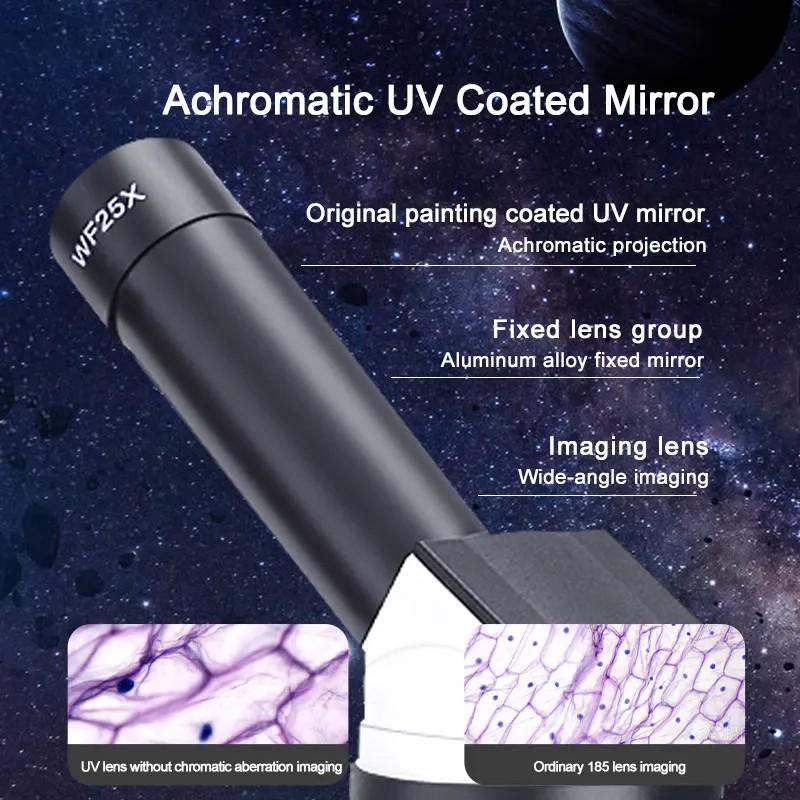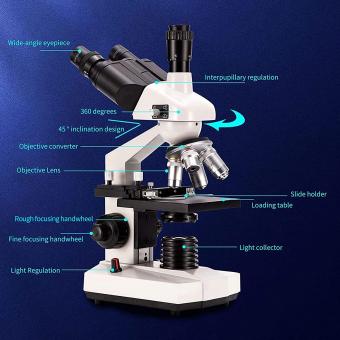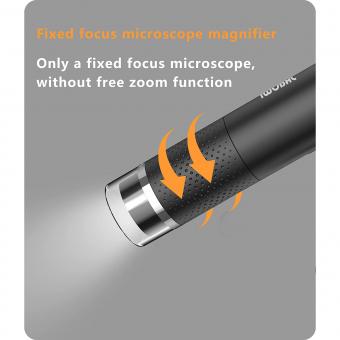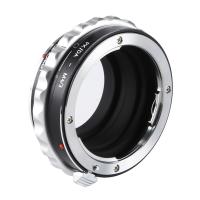What Is Magnification Power Of Microscope ?
The magnification power of a microscope refers to the degree to which the image of an object is enlarged when viewed through the microscope. It is a measure of how much larger the object appears compared to its actual size. Magnification power is determined by the combination of the objective lens and the eyepiece lens of the microscope. The objective lens is responsible for gathering light and forming the initial magnified image, while the eyepiece lens further magnifies this image for the viewer. The total magnification power is calculated by multiplying the magnification of the objective lens by the magnification of the eyepiece lens. For example, if the objective lens has a magnification of 10x and the eyepiece lens has a magnification of 20x, the total magnification power would be 200x. Different microscopes have different magnification powers, and higher magnification allows for more detailed observation of small structures.
1、 Total magnification: The product of the objective lens and eyepiece magnifications.
The magnification power of a microscope refers to the ability of the microscope to enlarge the image of the specimen being observed. It is a crucial factor in microscopy as it determines the level of detail and clarity that can be achieved during observation.
The total magnification of a microscope is the product of the magnification of the objective lens and the eyepiece. The objective lens is located near the specimen and is responsible for gathering light and forming the initial magnified image. The eyepiece, on the other hand, is located at the top of the microscope and further magnifies the image formed by the objective lens.
The magnification power of the objective lens is typically higher than that of the eyepiece. Objective lenses are available in various magnification powers, such as 4x, 10x, 40x, and 100x. The eyepiece usually has a fixed magnification power of 10x. Therefore, the total magnification of a microscope can range from 40x (4x objective lens multiplied by 10x eyepiece) to 1000x (100x objective lens multiplied by 10x eyepiece).
It is important to note that the total magnification is not the only factor that determines the quality of the image. Other factors, such as the numerical aperture of the lenses, the resolution of the microscope, and the quality of the optics, also play a significant role in achieving a clear and detailed image.
In recent years, advancements in microscopy technology have led to the development of high-powered microscopes with even greater magnification capabilities. For example, electron microscopes can achieve magnifications of up to several million times. These advanced microscopes have revolutionized scientific research and have allowed scientists to observe and study objects at the nanoscale.
In conclusion, the magnification power of a microscope is determined by the product of the objective lens and eyepiece magnifications. The total magnification determines the level of enlargement and detail that can be achieved during observation. However, it is important to consider other factors such as resolution and numerical aperture to obtain a clear and detailed image. With advancements in technology, microscopes with higher magnification powers have been developed, enabling scientists to explore the microscopic world in greater detail.

2、 Numerical aperture: Determines the resolving power and light-gathering ability of the lens.
The magnification power of a microscope refers to the ability of the microscope to enlarge the size of an object being observed. It is typically expressed as a ratio, such as 10x or 100x, indicating that the object appears 10 or 100 times larger than its actual size.
However, it is important to note that the magnification power alone does not determine the quality of the image produced by a microscope. Another crucial factor is the numerical aperture (NA) of the lens. The numerical aperture determines the resolving power and light-gathering ability of the lens.
Resolving power refers to the ability of a microscope to distinguish between two closely spaced objects as separate entities. The higher the numerical aperture, the better the resolving power of the microscope. This is because a larger numerical aperture allows more light to enter the lens, resulting in a sharper and more detailed image.
The light-gathering ability of the lens is also determined by the numerical aperture. A higher numerical aperture means that the lens can gather more light, resulting in a brighter image. This is particularly important when observing specimens that are not very transparent or have low contrast.
In recent years, there have been advancements in microscope technology that have improved the numerical aperture and, consequently, the resolving power and light-gathering ability of microscopes. For example, the development of high numerical aperture objectives and the use of techniques such as confocal microscopy and super-resolution microscopy have allowed scientists to observe structures and processes at a much finer scale.
In conclusion, while the magnification power of a microscope is important, the numerical aperture of the lens plays a crucial role in determining the quality of the image produced. A higher numerical aperture leads to better resolving power and light-gathering ability, resulting in sharper, more detailed, and brighter images. Ongoing advancements in microscope technology continue to push the boundaries of what can be observed and studied at the microscopic level.

3、 Digital magnification: Achieved through image processing and zooming capabilities.
The magnification power of a microscope refers to its ability to enlarge an object or specimen for detailed observation. Traditionally, magnification power was determined by the combination of the objective lens and the eyepiece lens. However, with the advent of digital technology, microscopes now offer additional magnification capabilities through image processing and zooming capabilities.
Digital magnification is achieved by capturing an image of the specimen using a digital camera attached to the microscope. The image is then processed and enlarged using software algorithms. This allows for further magnification beyond the limitations of the physical lenses. The level of digital magnification depends on the resolution of the camera and the software used for image processing.
The advantage of digital magnification is that it provides a higher level of detail and clarity compared to traditional optical magnification. It allows for precise examination of fine structures and enables researchers to capture and analyze images in real-time. Digital magnification also offers the ability to store and share images electronically, facilitating collaboration and documentation.
It is important to note that digital magnification does have its limitations. While it can enhance the level of detail, it cannot overcome the physical limitations of the microscope's resolution. Additionally, excessive digital magnification can result in pixelation and loss of image quality.
In recent years, advancements in digital imaging technology have led to the development of high-resolution cameras and sophisticated image processing algorithms. This has significantly improved the digital magnification capabilities of microscopes. Researchers and scientists can now achieve higher levels of magnification and resolution, allowing for more accurate and detailed analysis of specimens.
In conclusion, the magnification power of a microscope has been enhanced through digital technology. Digital magnification, achieved through image processing and zooming capabilities, provides researchers with the ability to observe and analyze specimens at a higher level of detail. With ongoing advancements in digital imaging, the magnification power of microscopes continues to improve, enabling scientists to push the boundaries of scientific discovery.

4、 Electron microscope magnification: Utilizes electron beams for higher magnification than optical microscopes.
The magnification power of a microscope refers to the degree to which an object can be enlarged and observed under the microscope. In the case of an electron microscope, the magnification power is significantly higher than that of an optical microscope.
Electron microscopes utilize a beam of electrons instead of light to magnify the specimen. This allows for much higher magnification and resolution, enabling scientists to observe objects at the nanoscale level. The magnification power of an electron microscope can range from a few hundred times to several million times, depending on the specific type of electron microscope and the techniques used.
One of the main advantages of electron microscopes is their ability to provide detailed images of structures that are too small to be resolved by optical microscopes. This has revolutionized various scientific fields, including materials science, biology, and nanotechnology. Electron microscopes have been instrumental in advancing our understanding of the atomic and molecular structures of materials, the intricate details of cellular components, and the behavior of nanoparticles.
It is important to note that the magnification power of an electron microscope is not the only factor that determines the quality of the image. The resolution, which refers to the ability to distinguish between two closely spaced objects, is also crucial. Electron microscopes can achieve much higher resolution than optical microscopes, allowing for the visualization of fine details and structures.
In recent years, there have been significant advancements in electron microscopy techniques, leading to even higher magnification powers and improved resolution. For example, the development of aberration-corrected electron microscopy has allowed for the visualization of individual atoms and atomic-scale defects in materials. Additionally, the introduction of cryo-electron microscopy has revolutionized the field of structural biology, enabling the determination of high-resolution structures of biological macromolecules.
In conclusion, the magnification power of an electron microscope is significantly higher than that of an optical microscope. Electron microscopes have revolutionized scientific research by providing detailed images of structures at the nanoscale level. Ongoing advancements in electron microscopy techniques continue to push the boundaries of magnification power and resolution, opening up new possibilities for scientific discovery and technological advancements.








































